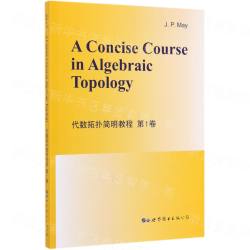-
内容大纲
代数拓扑是现代数学的基本部分,这个领域的知识对研究高级的与几何相关的工作(包括拓扑本身、微分几何、代数几何和李群等)来说是必不可少的。本书是一本代数拓扑的简明教程,书里包含了很多首次在教科书中出现的代数拓扑的最新研究进展。 -
作者介绍
-
目录
Introduction
Chapter 1 The fundamental group and some of its applications
1.What is algebraic topology?
2.The fundamental group
3.Dependence on the basepoint
4.Homotopy invariance
5.Calculations: π1 (R) =0 and π1 (S1) = Z
6.The Brouwer fixed point theorem
7.The fundamental theorem of algebra
Chapter 2 Categorical language and the van Kampen theorem
1.Categories
2.Functors
3.Natural transformations
4.Homotopy categories and homotopy equivalences
5.The fundamental groupoid
6.Limits and colimits
7.The van Kampen theorem
8.Examples of the van Kanpen theorem
Chapter 3 Covering spaces
1.The definition of covering spaces
2.The unique path lifting property
3.Coverings of groupoids
4.Group actions and orbit categories
5.The classification of coverings of groupoids
6.The construction of coverings of groupoids
7.The classification of coverings of spaces
8.The construction of coverings of spaces
Chapter 4 Graphs
1.The definition of graphs
2.Edge paths and trees
3.The homotopy types of graphs
4.Covers of graphs and Euler characteristics
5.Applications to groups
Chapter 5 Compactly generated spaces
1.The definition of compactly generated spaces
2.The category of compactly generated spaces
Chapter 6 Cofibrations
1.The definition of cofibrations
2.Mapping cylinders and cofibrations
3.Replacing maps by cofibrations
4.A criterion for a map to be a cofibration
5.Cofiber homotopy equivalence
Chapter 7 Fibrations
1.The definition of fibrations
2.Path lifting functions and fibrations
3.Replacing maps by fibrations
4.A criterion for a map to be a fibration
5.Fiber homotopy equivalence
6.Change of fiber
Chapter 8 Based cofiber and fiber sequences
1.Based homotopy classes of maps
2.Cones, suspensions, paths, loops
3.Based cofibrations
4.Cofiber sequences
5.Based fibrations
6.Fiber sequences
7.Connections between cofiber and fiber sequences
Chapter 9 Higher homotopy groups
1.The definition of homotopy groups
2.Long exact sequences associated to pairs
3.Long exact sequences associated to fibrations
4.A few calculations
5.Change of basepoint
6.n-Equivalences, weak equivalences, and a technical lemma
Chapter 10 CW complexes
1.The definition and some examples of CW complexes
2.Some constructions on CW complexes
3.HELP and the Whitehead theorem
4.The cellular approximation theorem
5.Approximation of spaces by CW complexes
6.Approximation of pairs by CW pairs
7.Approximation of excisive triads by CW triads
Chapter 11 The homotopy excision and suspension theorems
1.Statement of the homotopy excision theorem
2.The Freudenthal suspension theorem
3.Proof of the homotopy excision theorem
Chapter 12 A little homological algebra
1.Chain complexes
2.Maps and homotopies of maps of chain complexes
3.Tensor products of chain complexes
4.Short and long exact sequences
Chapter 13 Axiomatic and cellular homology theory
1.Axioms for homology
2.Cellular homology
3.Verification of the axioms
4.The cellular chains of products
5.Some examples: T, K, and RPn
Chapter 14 Derivations of properties from the axioms
1.Reduced homology; based versus unbased spaces
2.Cofibrations and the homology of pairs
3.Suspension and the long exact sequence of pairs
4.Axioms for reduced homology
5.Mayer-Vietoris sequences
6.The homology of colimits
Chapter 15 The Hurewicz and uniqueness theorems
1.The Hurewicz theorem
2.The uniqueness of the homology of CW complexes
Chapter 16 Singular homology theory
1.The singular chain complex
2.Geometric realization
3.Proofs of the theorems
4.Simplicial objects in algebraic topology
5.Classifying spaces and K (π, n) s
Chapter 17 Some more homological algebra
1.Universal coefficients in homology
2.The Kinneth theorem
3.Hom functors and universal coefficients in cohomology
4.Proof of the universal coeficient theorem
5.Relations between □ and Hom
Chapter 18 Axiomatic and cellular cohomology theory
1.Axioms for cohomology
2.Cellular and singular cohomology
3.Cup products in cohomology
4.An example: RPn and the Borsuk-Ulam theorem
5.Obstruction theory
Chapter 19 Derivations of properties from the axioms
1.Reduced cohomology groups and their properties
2.Axioms for reduced cohomology
3.Mayer-Vietoris sequences in cohomology
4.Liml and the cohomology of colimits
5.The uniqueness of the cohomology of CW complexes
Chapter 20 The Poincare duality theorem
1.Statement of the theorem
2.The definition of the cap product
3.Orientations and fundamental classes
4.The proof of the vanishing theorem
5.The proof of the Poincare duality theorem
6.The orientation cover
Chapter 21 The index of manifolds; manifolds with boundary
1.The Euler characteristic of compact manifolds
2.The index of compact oriented manifolds
3.Manifolds with boundary
4.Poincare duality for manifolds with boundary
5.The index of manifolds that are boundaries
Chapter 22 Homology, cohomology, and K (π, n) s
1.K (π, n) s and homology
2.K (π, n) s and cohomology
3.Cup and cap products
4.Postnikov systems
5.Cohomology operations
Chapter 23 Characteristic classes of vector bundles
1.The classification of vector bundles
2.Characteristic classes for vector bundles
3.Stiefel-Whitney classes of manifolds
4.Characteristic numbers of manifolds
5.Thom spaces and the Thom isomorphism theorem
6.The construction of the Stiefel-Whitney classes
7.Chern,Pontryagin,and Euler classes
8.A glimpse at the general theory
Chapter 24 An introduction to K-theory
1.The definition of K-theory
2.The Bott periodicity theorem
3.The splitting principle and the Thom isomorphism
4.The Chern character; almost complex structures on spheres
5.The Adams operations
6.The Hopf invariant one problem and its applications
Chapter 25 An introduction to cobordism
1.The cobordism groups of smooth closed manifolds
2.Sketch proof that N* is isomorphic to π* (TO)
3.Prespectra and the algebra H* (TO; Z2)
4.The Steenrod algebra and its coaction on H* (TO)
5.The relationship to Stiefel-Whitney numbers
6.Spectra and the computation of π* (TO)=π* (MO)
7.An introduction to the stable category
Suggestions for further reading
1.A classic book and historical references
2.Textbooks in algebraic topology and homotopy theory
3.Books on CW complexes
4.Differential forms and Morse theory
5.Equivariant algebraic topology
6.Category theory and homological algebra
7.Simplicial sets in algebraic topology
8.The Serre spectral sequence and Serre class theory
9.The Eilenberg-Moore spectral sequence
10.Cohomology operations
11.Vector bundles
12.Characteristic classes
13.K-theory
14.Hopf algebras; the Steenrod algebra, Adams spectral sequence
15.Cobordism
16.Generalized homology theory and stable homotopy theory
17.Quillen model categories
18.Localization and completion; rational homotopy theory
19.Infinite loop space theory
20.Complex cobordism and stable homotopy theory
21.Follow-ups to this book
Index
同类热销排行榜
- 目送/人生三书
-
 21世纪的《背影》 + 感人至深的“生死笔记”+ 龙应台亲手摄影 + 跨三代共读的人生之书!
华人世界率性犀利的一枝笔,龙应台独家...
21世纪的《背影》 + 感人至深的“生死笔记”+ 龙应台亲手摄影 + 跨三代共读的人生之书!
华人世界率性犀利的一枝笔,龙应台独家...
- 顾城的诗(金版)(精)/蓝星诗库
- 人类群星闪耀时(插图本)/译林名著精选
- 牛津高阶英汉双解词典(附光盘第8版)(精)
- 文化苦旅(新版)
- 摆渡人
- 解忧杂货店(精)
- 骆驼祥子
- 曾国藩(又笨又慢平天下)
- 查令十字街84号(珍藏版)(精)
推荐书目
-

孩子你慢慢来/人生三书 华人世界率性犀利的一枝笔,龙应台独家授权《孩子你慢慢来》20周年经典新版。她的《...
-

时间简史(插图版) 相对论、黑洞、弯曲空间……这些词给我们的感觉是艰深、晦涩、难以理解而且与我们的...
-

本质(精) 改革开放40年,恰如一部四部曲的年代大戏。技术突变、产品迭代、产业升级、资本对接...

 [
[
